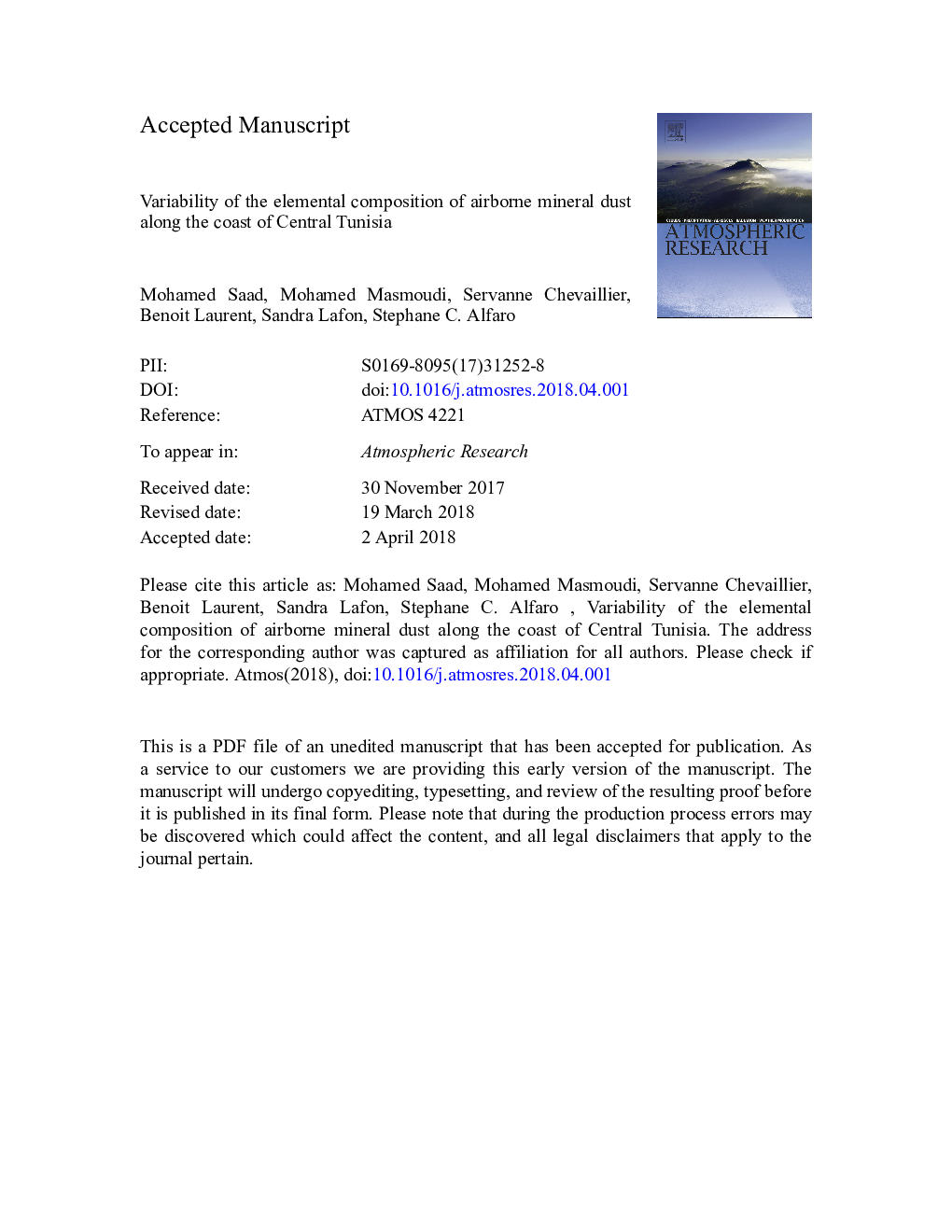| کد مقاله | کد نشریه | سال انتشار | مقاله انگلیسی | نسخه تمام متن |
|---|---|---|---|---|
| 8864604 | 1620472 | 2018 | 28 صفحه PDF | دانلود رایگان |
عنوان انگلیسی مقاله ISI
Variability of the elemental composition of airborne mineral dust along the coast of Central Tunisia
ترجمه فارسی عنوان
تنوع ترکیب عناصر گرد و غبار معدنی هوا در امتداد ساحل مرکزی تونس
دانلود مقاله + سفارش ترجمه
دانلود مقاله ISI انگلیسی
رایگان برای ایرانیان
موضوعات مرتبط
مهندسی و علوم پایه
علوم زمین و سیارات
علم هواشناسی
چکیده انگلیسی
The first aim of this study is to document the variability of the elemental composition of the mineral dust collected along the Mediterranean coast in Central Tunisia. The second aim is to correlate this composition with the different source-areas from which the mineral dust (MD) originates. In all, 190 daily aerosol samples are analyzed by X-Ray Fluorescence (XRF), and the elemental composition of the mineral dust is obtained by subtracting the non-crustal share from the bulk composition. On the basis of the MD concentration, 149 samples are classified as corresponding to “moderate” (3â¯<â¯MDâ¯<â¯25â¯Î¼gâ¯mâ3) dust-events, and 17 to “intense” (MDâ¯>â¯25â¯Î¼gâ¯mâ3) ones. By using a combination of MODIS satellite observations, HYSPLIT back-trajectory analysis, and dust emission simulations with the CHIMERE model, three geographical areas are identified as being at the origin of the intense events. From east to west, Area #1 corresponds to the south-east of Tunisia/west of Lybia region, Area #2 corresponds to the Algerian/Tunisian Border and contains the Chott El Jerid depression. Finally, Area #3 is in Central Algeria. Elemental ratios are commonly used to discuss the nature and origin of airborne particles. In good agreement with previous observations, the Ca/Al ratio is significantly larger in Area #1 than in Area #3 (2.4â¯Â±â¯0.4 as compared to 1.3â¯Â±â¯0.3). With values of 4.1â¯Â±â¯0.8 and 2.8â¯Â±â¯0.3 for Areas #1 and 3, respectively, a similar contrast is observed for the (Mgâ¯+â¯Ca)/Fe ratio. In Area #2 that is at the origin of 5 of the 9 intense events and thus appears as being the most influential source-region for Central Tunisia, the Ca/Al ratio (2.8â¯Â±â¯0.9) compares to that of Area #1 but (Mgâ¯+â¯Ca)/Fe (7.3â¯Â±â¯0.7) is significantly larger than in Areas #1 and 3. These differences of dust composition for the three source areas are confirmed by laboratory experiments in which mineral aerosols are generated using natural soils collected in the source regions and subsequently analyzed by XRF. These results do not only emphasize the strength of the link existing between the composition of the source soil and that of the aerosol generated from it, they also document the variability of the dust composition in the Central Mediterranean region and confirm the interest of using the Ca/Al and (Mgâ¯+â¯Ca)/Fe ratios as tracers of the source areas.
ناشر
Database: Elsevier - ScienceDirect (ساینس دایرکت)
Journal: Atmospheric Research - Volume 209, 1 September 2018, Pages 170-178
Journal: Atmospheric Research - Volume 209, 1 September 2018, Pages 170-178
نویسندگان
Mohamed Saad, Mohamed Masmoudi, Servanne Chevaillier, Benoit Laurent, Sandra Lafon, Stephane C. Alfaro,
